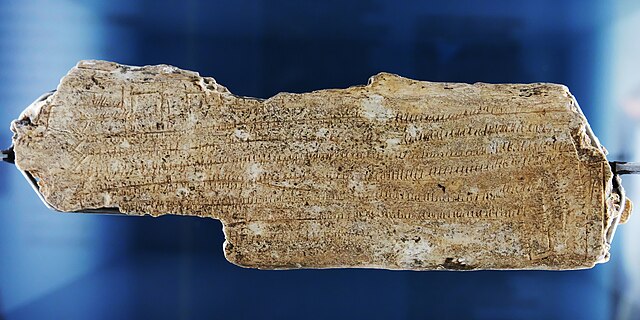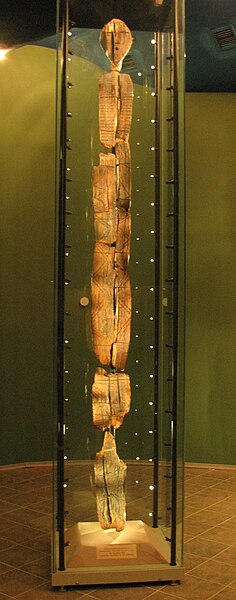The Azilian is a Mesolithic industry of the Franco-Cantabrian region of northern Spain and Southern France. It dates approximately 10,000–12,500 years ago. Diagnostic artifacts from the culture include projectile points, crude flat bone harpoons and pebbles with abstract decoration. The latter were first found in the River Arize at the type-site for the culture, the Grotte du Mas d'Azil at Le Mas-d'Azil in the French Pyrenees. These are the main type of Azilian art, showing a great reduction in scale and complexity from the Magdalenian Art of the Upper Palaeolithic.
Azilian
The Thaïs Bone, c. 12,000 BP.
Azilian painted pebbles from the cave of Le Mas d'Azil.
Harpoon – Mas d'Azil – Museum de Toulouse
The Mesolithic or Middle Stone Age is the Old World archaeological period between the Upper Paleolithic and the Neolithic. The term Epipaleolithic is often used synonymously, especially for outside northern Europe, and for the corresponding period in the Levant and Caucasus. The Mesolithic has different time spans in different parts of Eurasia. It refers to the final period of hunter-gatherer cultures in Europe and the Middle East, between the end of the Last Glacial Maximum and the Neolithic Revolution. In Europe it spans roughly 15,000 to 5,000 BP; in the Middle East roughly 20,000 to 10,000 BP. The term is less used of areas farther east, and not at all beyond Eurasia and North Africa.
Reconstruction of a "temporary" Mesolithic house in Ireland; waterside sites offered good food resources.
The Mesolithic begins during the latest Pleistocene, characterized by a progressive rise of temperatures, between the end of the Last Glacial Maximum and the Neolithic Revolution during the Holocene. Evolution of temperature in the Post-Glacial period according to Greenland ice cores.
Mesolithic artifacts
The Shigir Idol, from the east of the Ural mountains.








